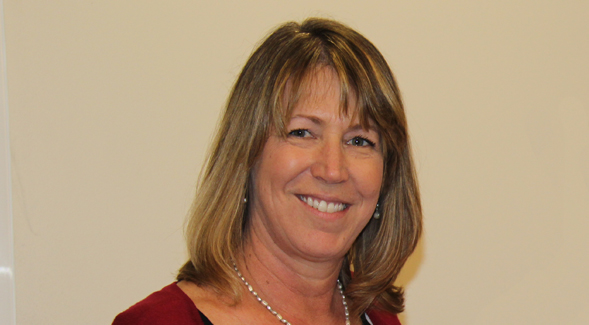Getting to Know Michele Goetz
Michele Goetz (92) traces the growth of research on Montezuma Mesa.

How did you first get your start as a grant and contract administrator at SDSU?
I started at the SDSU Foundation, as it was then called, in 1986 as a recent graduate from SDSU’s College of Business. As a student I was familiar with campus, but as an employee I gained a new perspective on how much goes into ensuring student success. I had worked at the Salk Institute for Biomedical Research while attending school, but had no idea at the time that there was research taking place at my own university. Although the volume of proposals and awards was still relatively small, it was growing rapidly under the vision of SDSU President Thomas B. Day.
How much has SDSU changed since then?
The university’s award volume in 1986 was $32 million. The foundation was housed in a collection of small houses and apartments located on the south edge of campus, and we had just invested in desktop computers with dual disc drives. This past year, researchers at SDSU submitted more than 1,000 proposals and received $130 million in awards. Total revenues have increased from $44 million when I began to $226 million now. The difference is not just in the dollar amount of awards or number of awards, but also in the breadth and scope of the types of activities funded, the increased collaborations and interdisciplinary nature of the research, and the strong support of research by the university.
What have been some of your proudest moments?
My proudest moments at SDSURF are not necessarily the big events, although there have been many initiatives that I am proud to have played a role in implementing. I really value those moments when I can see in some way that my actions have benefited a researcher, a staff member or a student.
I met with a researcher this week as part of my efforts to solicit input on foundation services. He told me how happy he was at SDSU, that the space we provided accommodated his needs, his grant specialist was extremely competent and helpful and his students were obtaining valuable experience working on his projects. I left his office proud of our team and their efforts, which are contributing to the success of that researcher. I’m very proud of the team I work with and the can-do attitude they bring to their jobs, their focus on continuous improvement and their dedication to SDSU and the faculty, staff and students we support.
What motivates you in your work?
I am motivated by curiosity and a love of learning. I have a strong need to understand things for myself. I get satisfaction from solving problems and improving processes, and I enjoy helping others. As a result, I enjoy working in the academic community where the creativity of our faculty forces me to think creatively myself to find ways to support their efforts in a constantly changing regulatory environment.
Do you have any plans for the immediate future in your new role?
I have spent the past six months meeting with researchers, board members, foundation staff and other stakeholders and doing a lot of listening. Based on this input, I have implemented a restructuring of the foundation management team and have redirected resources to provide direct services to our researchers. We are also continuing to streamline and automate processes, enhance services and partner with Stephen Welter, our vice president for research, to improve the infrastructure needed to support and grow the research enterprise at SDSU.
In your words, how would you describe SDSU's strengths when it comes to competing for grants and contracts?
SDSU faculty continue to be very successful in obtaining funding in an increasingly competitive environment. Our faculty have excellent reputations and are at the cutting edge in their fields. They are extremely collaborative, and many of our proposals are submitted for interdisciplinary programs, community partnerships and involve students—all of which are appealing to funding agencies.
The other piece is the university’s commitment to research. Our president, vice presidents and deans are huge supporters of our researchers and the research infrastructure necessary to facilitate their work. Last year, for example, the university invested $2.5 million in research for areas of excellence, facilities improvement, and equipment and graduate fellowships.
I would say SDSU’s strengths lay in our distinguished faculty and our university’s support of research. I hope in a small way, our competent and dedicated staff at the research foundation help take some of the administrative burden off faculty so that we also can facilitate their work.



